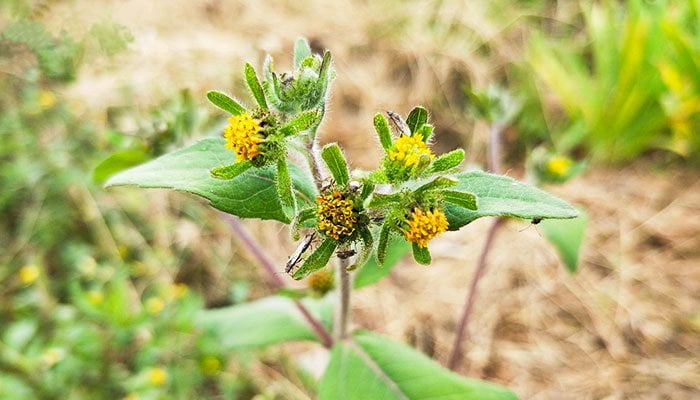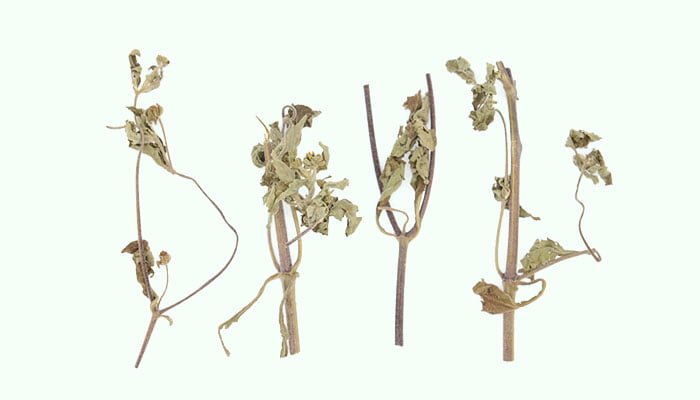What Is Xi Xian Cao
Xi Xian Cao commonly known as Herba Siegesbeckiae is the above-ground part of Siegesbeckia orientalis, Siegesbeckia pubescens, or Siegesbeckia glabrescens, which is an annual herb belonging to the family Compositae. It is a relatively practical Chinese herbal medicine, which first appeared in <Tang Ben Cao> in 659 AD.
There are 11 species of Siegesbeckia, which are distributed in tropical, subtropical, and temperate regions. Some of these species are used medicinally, such as Siegesbeckia orientalis, Siegesbeckia pubescens, and Siegesbeckia glabrescens.
Siegesbeckia orientalis is commonly known as St. Paul’s wort. They often grow in the mountains, barren grasslands, cultivated fields, shrubs, and forests at an altitude of 110-2,700 meters. They are widely distributed in tropical, subtropical, and temperate regions of Europe, Russia, Korea, Japan, China, Southeast Asia, and North America.

Siegesbeckia pubescens often grow in wetlands, valley forest margins, river valleys, streamsides, undergrowth forest lawns, slopes, open fields, or cultivated borders at altitudes of 160-3,400 meters. At present, they have not been introduced by artificial cultivation. They are distributed in north-central, south-central and southeastern China, India, Russia, South Korea, and Japan.
Siegesbeckia glabrescens often grow along roadsides, wilderness grasslands, and hillside shrubs at altitudes of 300-1,000 meters. They are distributed in central and northern China, Korea, and Japan.
In the summer and autumn of each year, before or during the flowering of Siegesbeckia, people gather the above-ground parts of Siegesbeckia orientalis, Siegesbeckia pubescens, or Siegesbeckia glabrescens, remove impurities, dry them in the sun, cut them into sections, use them directly, or steam them with yellow rice or millet wine, and make them into Chinese herbal medicines.
Xi Xian Cao contains orientalin A, orientalin B, darutigenol, darutoside, neodarutoside, 12-hydroxykirenol, 2-keto-16-acetyloxykirenol, kirenol pubeside A-D, 7β-hydroxydarutigenol, 9β-hydroxydarutigenol, 16-O-acetyldarutigenol, 16-O-acetyldarutoside, pubeside E, siegesbeckiol, siegesbeckioside, siegesbeckic acid, siegesesteric acid, siegesetheric acid, grandifloric acid, orientalide, orientin, luteolin, quercetin, 3,7 -dimethylquercetin, 3-O-methylquercetin, apigenin, kaempferol, isorhamnetin, liquiritin, isoliquiritin, vitexin, baicalin, luteoloside, hesperidoside, rutin, myricetin, organic acids, esters, fatty acids, sterols, coumarins, and alkaloids.
Generally, the dark green Xi Xian Cao with thicker stems and more leaves is preferred.
According to <Compendium of Materia Medica>, the medicinal nature of Xi Xian Cao is relatively cold, with a pungent and bitter taste. It has a certain therapeutic effect on the pathological changes of the liver and kidney meridians.
In traditional Chinese medicine, it is often used to expel wind and dampness, ease joint movement, remove toxins, and treat rheumatic arthralgia, weakness of muscles and bones, soreness and weakness of waist and knees, tetraplegia, urarthritis, knee osteoarthritis, hypertension, systemic lupus erythematosus, vitiligo, stroke, facial distortion, hemiplegia, cerebral thrombosis, cerebral infarction, cerebrovascular accident sequelae, lumbar disc herniation, acute enteritis, rubella, sores, malaria, psoriasis, primary biliary cirrhosis, acute icteric hepatitis, and nyctalopia. It is an important component of Xi Tong Wan and Xi Hong Tong Luo Kou Fu Ye.
Benefits
- Anti-inflammation, inhibiting xylene-induced ear swelling in mice and carrageenan-induced paw swelling in rats.
- Increasing pain threshold, prolonging the time of licking hindfoot in mice induced by hot plate experiment, and reducing the number of writhing in mice induced by acetic acid.
- Inhibiting adenosine diphosphate-induced platelet aggregation, reducing hematocrit, whole blood viscosity, and plasma viscosity.
- Attenuating acute myocardial injury induced by doxorubicin in rats.
- Inhibiting the contraction of the aortic ring, dilating blood vessels, and lowering blood pressure.
- Inhibiting acetamide and trinitrobenzenesulfonic acid-induced colitis in rats with bodyweight loss, diarrhea, blood in stool, and improving colon congestion and ulceration.
- Expelling wind and dampness, easing joint movement, treating rheumatic arthralgia, weakness of muscles and bones, soreness and weakness of waist and knees, and tetraplegia.
- Activating meridians, treating stroke, facial distortion, and hemiplegia.
- Expelling wind and draining off dampness, treating itching caused by rubella and sores.
- Clearing heat and removing toxins, treating sores, carbuncles, redness and swelling of joints caused by heat toxins.
- Treating the carbuncle of the back and deep-rooted boils.
- Darutoside can stimulate the uterus and has an obvious anti-early pregnancy effect.
- Kirenol can down-regulate the expression of peroxisome proliferator-activated receptor γ (PPARγ), transcription factor CCAAT/ enhancer-binding protein (C/EBPα), and inhibit adipocyte differentiation and lipid accumulation.
- Its methanol extract has a significant repairing effect on experimental rat skin damage. The mechanism is the activation of mouse fibroblast production and the promotion of wound healing.
- Its water extract and alcoholate can reduce the increase of blood sugar in rats induced by streptozotocin, and improve the insulin sensitivity of diabetic rats induced by streptozotocin.
- Its total flavonoids can improve neurological deficits in rats, reduce the size of cerebral infarction, increase the activities of superoxide dismutase and glutathione peroxidase in brain tissue, reduce the content of malondialdehyde in brain tissue, and slow down cerebral ischemia damage.
- Inducing apoptosis in chronic myeloid leukemia K562 cells, endometrial cancer RL95-2 cells, colon cancer SW480 cells, breast cancer MCF-7 cells, and liver cancer HepG2 cells.
- Inhibiting Staphylococcus aureus, Escherichia coli, Pseudomonas aeruginosa, Typhoid Bacillus, Bacillus enteritidis, Staphylococcus albus, neisseria catarrhalis, Streptococcus iniae, and Glomerella cingulata.
- Studies have found that it can enhance the proliferation of T cells in adjuvant arthritis rats, inhibit the activity of IL-1, and promote the activity of IL-2.
- Its aqueous extract can inhibit systemic immune responses induced by a mixture of antigens (containing ovalbumin, Bordetella pertussis, and alum). It has an immunosuppressive effect.
Combinations
- It can be combined with Chou Wu Tong (Folium Clerodendri), etc. to treat rheumatic arthralgia, weakness of muscles and bones, soreness and weakness of the waist and knees, and tetraplegia.
- It can be used in combination with Chinese Moccasin (Bai Hua She), Huang Qi (Radix Astragali), Dang Gui (Radix Angelicae Sinensis), Wei Ling Xian (Radix Clematidis), etc. to treat stroke, facial distortion, and hemiplegia.
- It can be used in combination with Bai Ji Li (Fructus Tribuli), Di Fu Zi (Kochiae Fructus), Bai Xian Pi (Cortex Dictamni), etc. to treat rubella and sores.
- It can be used in combination with Pu Gong Ying (Dandelion), Ye Ju Hua (Wild Chrysanthemum Flower), etc. to treat sores, carbuncles, redness and swelling of joints caused by heat toxins.
- It can be used in combination with Xiao Ji (Cirsium Setosum), Zi Hua Di Ding (Viola Yedoensis), etc. to treat the carbuncle of the back, and deep-rooted boils.
Side Effects
- Overdose of it may cause vomiting.
- After the patient stops taking the medicine, if the vomiting is not relieved, the patient should go to the hospital for treatment in time.
Precautions and Warnings
- The dosage of Xi Xian Cao should be controlled at 9-12g.
- It can be made into decoctions, pills, powders, medicinal liquors, or mashed for external use.
- People who are allergic to Xi Xian Cao should not take it.
- The wine-steamed Xi Xian Cao is often used to treat rheumatic arthralgia and hemiplegia, and unprocessed Xi Xian Cao is often used to treat rubella and eczema
- Patients with insufficiency of blood should not take it.
- It should not be taken by pregnant women, nursing mothers, and those who are trying to conceive.
- The elderly should take it under the guidance of a doctor.
